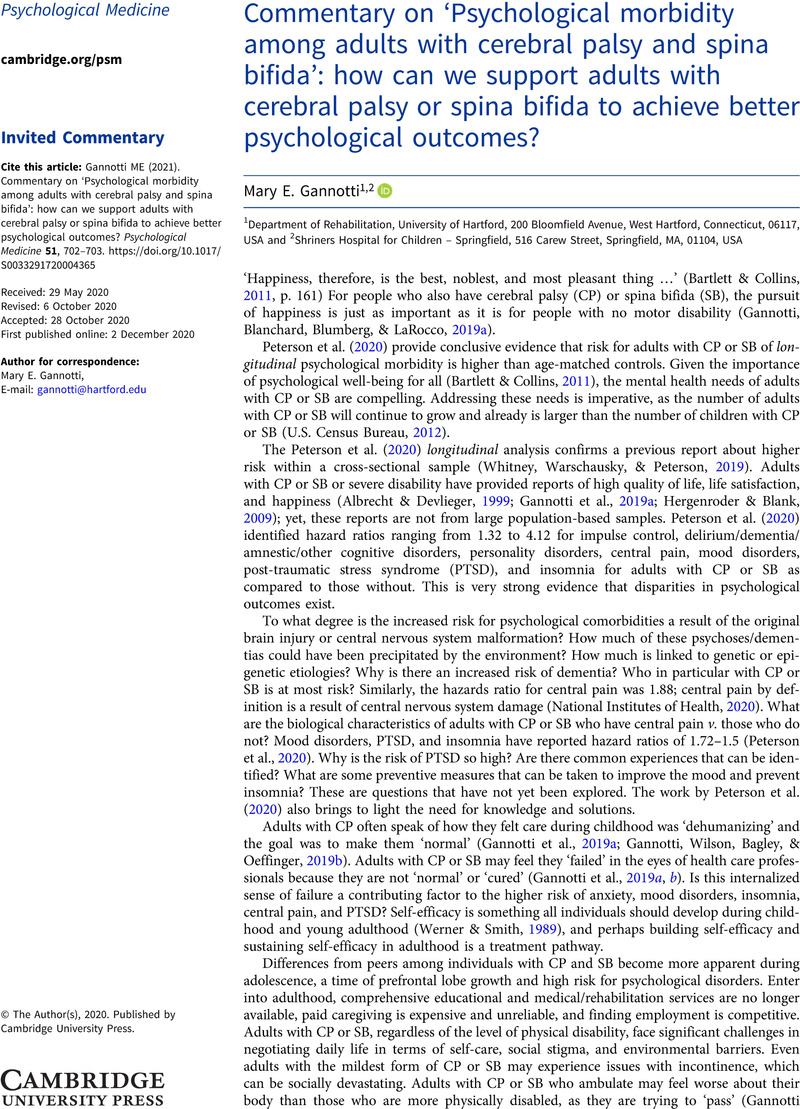No CrossRef data available.
Article contents
Commentary on ‘Psychological morbidity among adults with cerebral palsy and spina bifida’: how can we support adults with cerebral palsy or spina bifida to achieve better psychological outcomes?
Published online by Cambridge University Press: 02 December 2020
Abstract
An abstract is not available for this content so a preview has been provided. Please use the Get access link above for information on how to access this content.

- Type
- Invited Commentary
- Information
- Copyright
- Copyright © The Author(s), 2020. Published by Cambridge University Press.
References
Albrecht, G. L., & Devlieger, P. J. (1999). The disability paradox: High quality of life against all odds. Social Science & Medicine, 48(8), 977–988.CrossRefGoogle ScholarPubMed
Aristotle, ., Bartlett, R. C., & Collins, S. D (trans). (2011). Aristotle's Nicomachean ethics / Aristotle; translated, with an interpretive essay, notes, and glossary by Robert C. Bartlett and Susan D. Collins. Chicago: London: The University of Chicago Press.Google Scholar
Gannotti, M. E., Blanchard, Y., Blumberg, L., & LaRocco, D. (2019a). Shared meanings of success, happiness, and health among adults with cerebral palsy and physiotherapists: Implications for practice and research. Disability & Rehabilitation, 41, 1321–1330.CrossRefGoogle Scholar
Gannotti, M. E., Minter, C. L., Chambers, H. G., Smith, P. A., & Tylkowski, C. (2011). Self-concept of adults with cerebral palsy. Disability & Rehabilitation, 33(10), 855–861.CrossRefGoogle ScholarPubMed
Gannotti, M. E., Wilson, J. L., Bagley, A. M., & Oeffinger, D. (2019b). Adults with cerebral palsy rank factors associated with quality of life and perceived impact of childhood surgery on adult outcomes. Disability & Rehabilitation, 1–8. doi: 10.1080/09638288.2019.1701718.CrossRefGoogle Scholar
Hergenroder, H., & Blank, R. (2009). Subjective well-being and satisfaction with life in adults with spastic cerebral palsy: A pilot study of a randomized sample. Developmental Medicine Child Neurology, 51, 389–396.CrossRefGoogle ScholarPubMed
National Institutes of Health (2020). Central pain syndrome information page. Washington, DC: National Institutes of Health. Retrieved from https://www.ninds.nih.gov/Disorders/All-Disorders/Central-Pain-Syndrome-Information-Page.Google Scholar
Peterson, M., Lin, P., Kamdar, N., Mahmoudi, E., Marsack-Topolewski, C., Haapala, H., … Muraszko, K. (2020). Psychological morbidity among adults with cerebral palsy and spina bifida. Psychological Medicine, (in press).Google ScholarPubMed
U.S. Census Bureau (2012). 2010 Census of population and housing, population and housing unit counts, CPH-2-1, United States summary. Washington, DC: U.S. Government Printing Office.Google Scholar
Werner, E., & Smith, R. (1989). Vulnerable but invincible: A longitudinal study of resilient children and youth. New York, New York: Adams, Banister, Cox.Google Scholar
Whitney, D. G., Warschausky, S. A., & Peterson, M. D. (2019). Mental health disorders and physical risk factors in children with cerebral palsy: A cross-sectional study. Developmental Medicine Child Neurology, 61, 579–585.CrossRefGoogle ScholarPubMed



